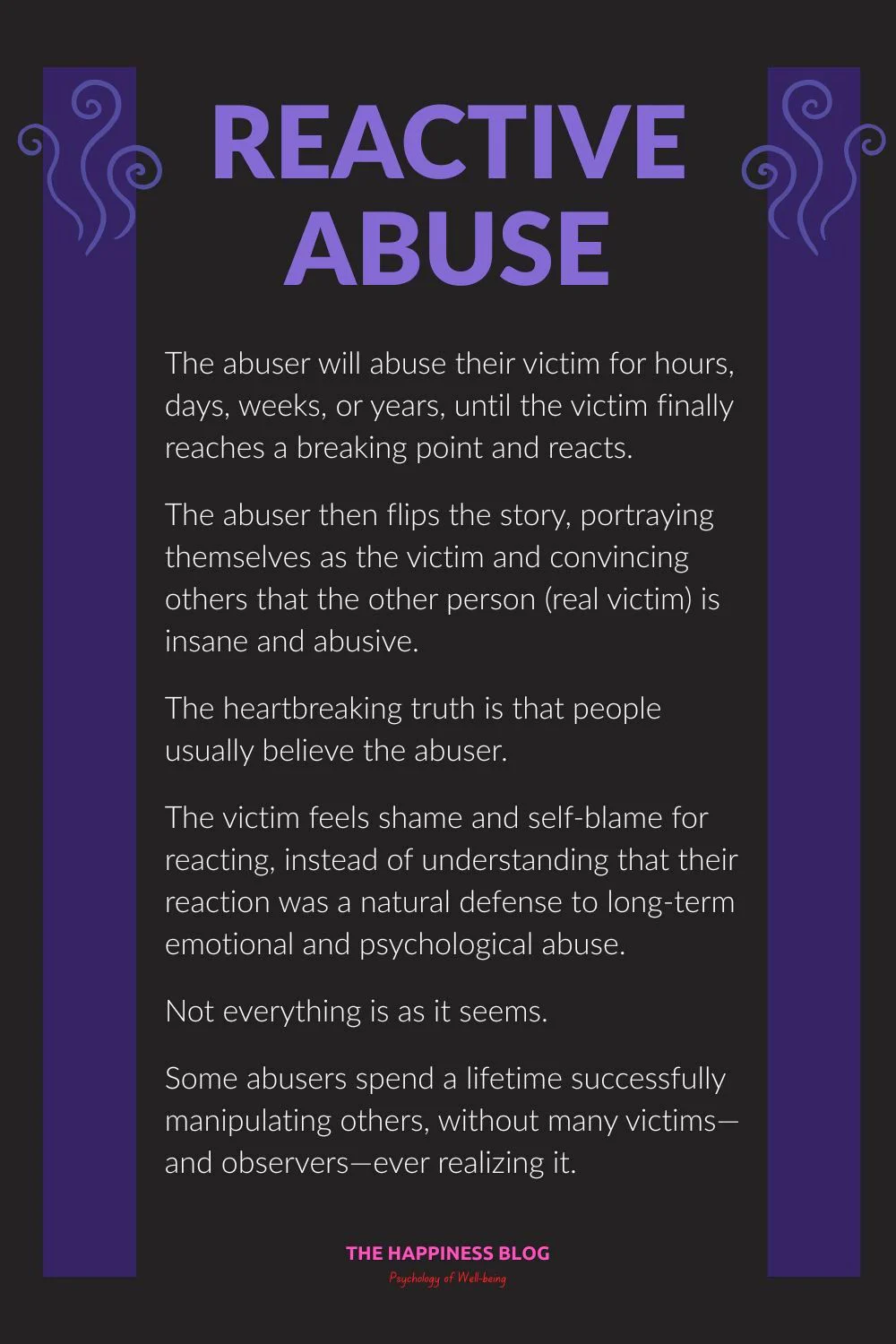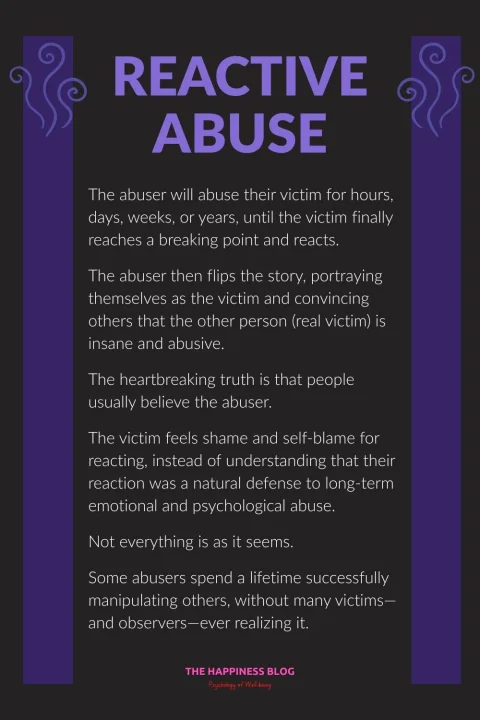Today's Thursday • 8 mins read
This psychological trap has a name: reactive abuse. Let’s see how this unfolds.
Sarah had always been the calm one. The mediator. The person friends called when they needed level-headed advice.
Then one evening, after another three-hour argument that went nowhere, she threw a plate across the kitchen. Her partner immediately pulled out his phone, recording the broken plate and her tears and rage.
Within days, his family knew she was “unstable.” Her own friends started asking careful questions about her mental health.
What nobody saw was the eight months before that moment. The constant criticism and silent treatment. The way every conversation somehow became about her failures.
That was the point where many people find themselves: blamed for reactions to abuse that nobody else witnessed.
What Reactive Abuse Really Means
Reactive abuse occurs when a person who has been long-abused finally snaps and reacts with anger, hostile behavior, or emotional intensity.
The original abuser then uses that reaction as proof that the victim is unstable, reactive, and harmful.
So reactive abuse is not abuse at all, but rather the victim’s self-defense reaction to actual abuse.
It is slow manipulation.
The manipulator constantly criticizes the victim, makes unjust demands, and creates intense conditions, pushing the victim to the edge of tolerance.
Then, when the victim reacts aggressively, such as by yelling, throwing things, or hitting, the manipulator highlights it as abuse.

The Build-Up To Reaction That Nobody Sees
Reactive abuse follows a predictable pattern:
- The Erosion Phase: The abuser incessantly chips away at their target’s sense of reality, confidence, and self-worth. They criticize non-stop, withhold love as punishment, or twist conversations until the victim starts to doubt their own memory and perception (gaslighting).
- The Pressure Cooker: As time passes, the victim tries every healthy response. They communicate calmly, set boundaries, seek compromise, or withdraw to keep the peace. Nothing works because the abuser’s goal was never resolution, but control.
- The Breaking Point: Eventually, the nervous system can only take so much. The victim explodes in anger, tears, or desperation. This reaction is often completely out of character for them, which makes it even more shocking to witness.
- The Role Reversal: The abuser instantly switches into victim mode. They appear calm, reasonable, even concerned. They tell others, “See? This is what I’ve been dealing with. She’s unstable,” labeling the target as the offender.

- One-quarter of physical harm between intimate partners may involve one partner reacting to the other partner’s psychological abuse. A study of couples with mutual physical hostile behavior found 27% of men and 22% of women committed aggressive acts in self-defense (Babcock & Snead, 2019).
Why People Believe The Victim Is The Wrong Person
The tragic effectiveness of reactive abuse is based on presentation and perception.
We see it in relationships with narcissists. The way they present it is convincing.
Your narcissist cultivates a public image of being a reasonable, charming, and kind person. But in private, they subject you to constant manipulation, criticism, and emotional assaults.
You eventually reach your breaking point and yell, throw something, or say things you never thought you’d say.
Then everything flips. Suddenly, you are the problem.
- Your narcissist declares that your outburst is proof of your emotional and mental instability.
- Friends and family see your reaction without the build-up and begin to doubt you.
- Even you start asking yourself, “Am I the abuser?”
Outsiders find reactive abuse convincing because they simply cannot believe that the narcissist, who has an impeccable public image, can do anything wrong with you.
So, when they see or hear about your dramatic reaction, they believe it is in your nature to react abusively to the “innocent” narcissist.
Moreover, when you do react, you are usually at your worst. You’re most likely confused, frustrated, and emotionally drained.
So your reaction often comes out on a scale far bigger than any imaginable trigger. Since the narcissist has reversed the victim and offender roles, you begin to feel ashamed of your outburst.
Soon, you start to apologize profusely, take full responsibility, and promise to keep your reactions in control. Unknowingly, you start to act like a repentant criminal.
Your remorse looks like accountability to others. But it’s actually the response of someone who’s been conditioned to believe everything is their fault.
The abuser’s calm demeanor after provoking a reaction creates a stark contrast. They might even record your meltdown, collecting evidence to show friends, family, or authorities.
This calculated approach makes their story more believable than the victim’s attempts to explain months or years of invisible torment.
People naturally trust what they can see. A screaming, crying person throwing objects is visible.
The systematic erosion of someone’s boundaries, the gaslighting, and the strategic withdrawals of love leave no physical evidence. The audience sees only the finale, not the script that led there.
The Confusion of Being Your Own Worst Evidence
One of the cruelest aspects of reactive abuse is how it makes victims doubt their reality.
You know you screamed. You know you said horrible things or acted in ways that don’t match your values. The evidence of your “bad behavior” is right there.
Emotional abuse doesn’t leave visible bruises. Its effects are cumulative, invisible, and easy for others to dismiss.
What you can’t easily see or articulate is the systematic psychological warfare that preceded your breakdown.
This confusion serves the abuser’s purpose perfectly. If you’re busy questioning whether you’re the real problem, you’re not setting boundaries or leaving the relationship.
You’re focused on fixing yourself rather than recognizing the dynamic at play.
Signs You Might Be Experiencing Reactive Abuse
You find yourself acting in ways that feel completely foreign to who you are. Friends or family from before this relationship wouldn’t recognize your behavior.
Your emotional reactions seem disproportionate even to you, but when you try to explain the fuller context, it sounds like you’re making excuses.
After your outbursts, you feel intense shame and regret. Meanwhile, the other person seems eerily calm and uses your reaction to prove their point about your character.
You’re constantly apologizing and trying to manage your emotions better, but the situation never improves. In fact, your efforts to “work on yourself” seem to give the other person more ammunition.
People outside the relationship express concern about your behavior, but they don’t see or understand what happens in private.
How To Break Free From Reactive Abuse
First, tell yourself that reactive abuse is not abuse, but rather a reaction to the offender’s abuse.
Once you’ve recognized the reactive abuse, other steps forward are:
- Distance yourself: Create space from the person triggering these reactions. Many people are shocked by how quickly they return to their baseline when they’re no longer in constant contact with their abuser.
- Document the evidence: Keep a private record of interactions to help yourself see patterns that are invisible at the moment. Even if it isn’t about building a legal case, keeping records will strengthen your trust in your own perception.
- Stop the self-blame: Assure yourself that your reactions are a result of sustained mistreatment, not proof that you are abusive. Anyone else would have reacted similarly to that inhuman treatment. Understanding reactive abuse means recognizing you were pushed beyond reasonable limits.
- Learn from the event. Acknowledge and apologize where appropriate. But know this for sure: The real lesson is not about becoming better at tolerating abuse. The actual lesson is to understand that your reaction was a foreshadowing of future events. They can push you past your breaking point, and it can happen more often.
Once you grasp your situation clearly, consider talking to a supportive person or working with a trauma-informed therapist.
They can suggest what to do if you choose to stay in the relationship, how to avoid being triggered, and how not to react with intense outbursts. They can help you rebuild your sense of self.
Final Words
Some people spend a lifetime perfecting the art of manipulation. These master manipulators layer polished public personas over private cruelty.
They engineer and then weaponize your breaking point against you, in a way that they are reasonable, and you are the problem, always.
If you find yourself cast as the reactive abuser, know this: your response does not define who you are. It is not your character flaw.
Step away. Heal. Reconnect with who you were before this relationship rewired your reality.
√ Also Read: How To Unmask And Expose A Narcissist?
√ Please share this with someone.
» You deserve happiness! Choosing therapy could be your best decision.
...
• Disclosure: Buying via our links earns us a small commission.
